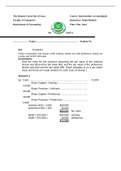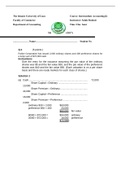Module 2: DEVOPS Introduction............................................................................................................2
Module 3: Culture...................................................................................................................................7
Module 4: Organization........................................................................................................................12
Module 5: Processes.............................................................................................................................18
Module 6: Automation.........................................................................................................................23
Module 7: Measure and Improvement.................................................................................................30
“Module 8”: Vragen van lerares:..........................................................................................................34
“Module 9”: Extra vragen van Internet.................................................................................................35
..............................................................................................................................................................39
,Module 2: DEVOPS Introduction
2.1: Emergence of DevOps 50% (3 Qs x 3)
Slide 12: Building a Business Case for DevOps: 10 Reasons for Investing in it
How does the DevOps approach enable an organization to increase speed to market and
gain competitive edge?
A. DevOps allows teams to spend more time on technical innovation while maintaining
stability and quality.
B. DevOps enables an organization to go from an initial concept to a viable product in a
shorter timescale than was traditionally acceptable with a Waterfall approach.
C. DevOps makes you more aware of the challenges that each department faces on a
day-to-day basis and helps understand the needs of the business.
D. The environment and culture of DevOps encourage a deeper understanding and
implementation of best practices in an organization.
Slide 12: Building a Business Case for DevOps: 10 Reasons for Investing in it (Contd.)
Which goals will you consider when building a business case for a DevOps organization?
1. Expanding market share by acquisition of a large competitor
2. Improving collaboration between all layers of your organization
3. Increasing overall stability of your IT systems
4. Reducing the amount of failures introduced during the software development lifecycle
A. 1, 2, and 3
B. 1, 3, and 4
C. 1, 2, and 4
D. 2, 3, and 4
Slide 12: Building a Business Case for DevOps: 10 Reasons for Investing in it (Contd.)
Continuous Integration and Delivery practices can increase the frequency of deploying
source code into production. What is the increased frequency according to the 2015 State of
DevOps survey by PuppetLabs?
A. 2 times
B. 5 times
C. 30 times
D. 100 times
Slide 5: Typical Challenges Traditional IT Organizations Face
In a traditional organization, Development and Operations teams face various
communication challenges. Which is a proven tactic for the Development team to enable the
Operations team to solve known issues without any delays?
A. Developing and sharing knowledge articles
B. Sharing their experience of the Production environment
C. Sharing the required information to perform the same work
D. Taking the responsibility of solving any issues raised by the clients
Slide 4: Typical Challenges Traditional IT Organizations Face
Why does “Wall of Confusion” exist between Development and Operations in traditional IT
,organizations?
A. Developers do not allow Operations’ people to visit them during office hours.
B. The Operations team do not participate in meetings organized by the Development
team.
C. The Development (Stability) and Operations (Change) teams have different priorities
and goals.
D. Some rogue developers diffuse the role of Operations by building their own cloud-
based platforms.
Slide 8: Problems
What are the challenges between the Development and Operations teams in a traditional
organizations?
1. Blame game between Dev and Ops
2. Different tools used between Dev and Ops
3. No feedback loop between Dev and Ops
4. Variance in skill set levels between Dev and Ops
A. 1, 2, and 3
B. 1, 3, and 4
C. 1, 2, and 4
D. 2, 3, and 4
Slide 11: Building Antifragile Organizations Using DevOps
What are the three core ingredients of an antifragile organization?
1. Agile
2. DevOps
3. Kaizen Mindset
4. Lean Startup
5. Management Innovation
A. 1, 2, and 3
B. 1, 4, and 5
C. 2, 3, and 4
D. 2, 4, and 5
Slide 11: Building Antifragile Organizations Using DevOps
Which phrase fits BEST as a characteristic of a Lean startup?
A. Single piece of flow
B. Short feedback loops
C. Use of cloud platforms
D. Validated learning
Slide 11: Building Antifragile Organizations Using DevOps
Which phrase fits BEST as a characteristic of a DevOps team, which is part of an antifragile
organization?
A. Employee First
B. Honor Web-inspired value
C. Minimum Viable Bureaucracy
D. Self-management
, 2.2: Core concepts of Devops 50% (3 Qs x 3)
Slide 24: DevOps Principle #1: Customer-Centric Action
Which DevOps principle encourages “No Bureaucracy” and focuses on no barriers to ask
questions?
A. Automate everything you can
B. Continuous improvement
C. Create with the end in mind
D. Customer-centric action
Slide 25: DevOps Principle #2: Create with the End in Mind
Which DevOps principle focuses on product and service thinking?
A. Automate everything you can
B. Create with the end in mind
C. Continuous Improvement
D. Customer-centric action
Slide 25: DevOps Principle #5: Continuous Improvement
Which DevOps principle appreciates measuring processes, people, and tools?
A. Continuous improvement
B. Create with the end in mind
C. Cross-functional autonomous teams
D. End-to-end responsibility
Slide 24: DevOps Principle #4: Cross-Functional Autonomous Teams
What is required to have fully autonomous teams throughout the lifecycle of a product?
A. Balanced set of knowledge and skills
B. End-to-end responsibility
C. Risk taking ability
D. Transparency
Slide 23: DevOps Principle #3: End-to-End Responsibility
What are the key characteristics of “End-to-End Responsibility” in a DevOps context?
1. Complementary skills
2. Concept to grave
3. Engineering mindset
4. Performance support
5. Automate everything you can
A. 1 and 5
B. 1, 2, and 5
C. 2 and 4
D. 2, 3, and 5
Slide 22: DevOps Principle #2: Create with the End in Mind
Which tasks will you do to apply DevOps principle “Create with the End in Mind”?
1. Avoid Waterfall and process-oriented models.
2. Create a detailed product roadmap for the coming 3 years.
3. Strive towards the delivery of MVPs.
4. Optimize speed, cost, and ease of delivering.
5. Bring software into production, multiple times a day without hassle.
A. 1 and 3
B. 1, 3, and 4
C. 2 and 3



